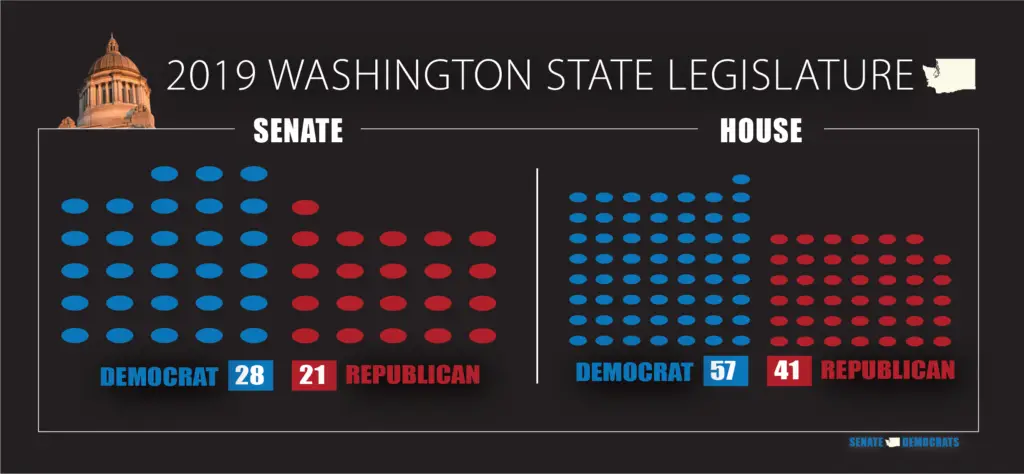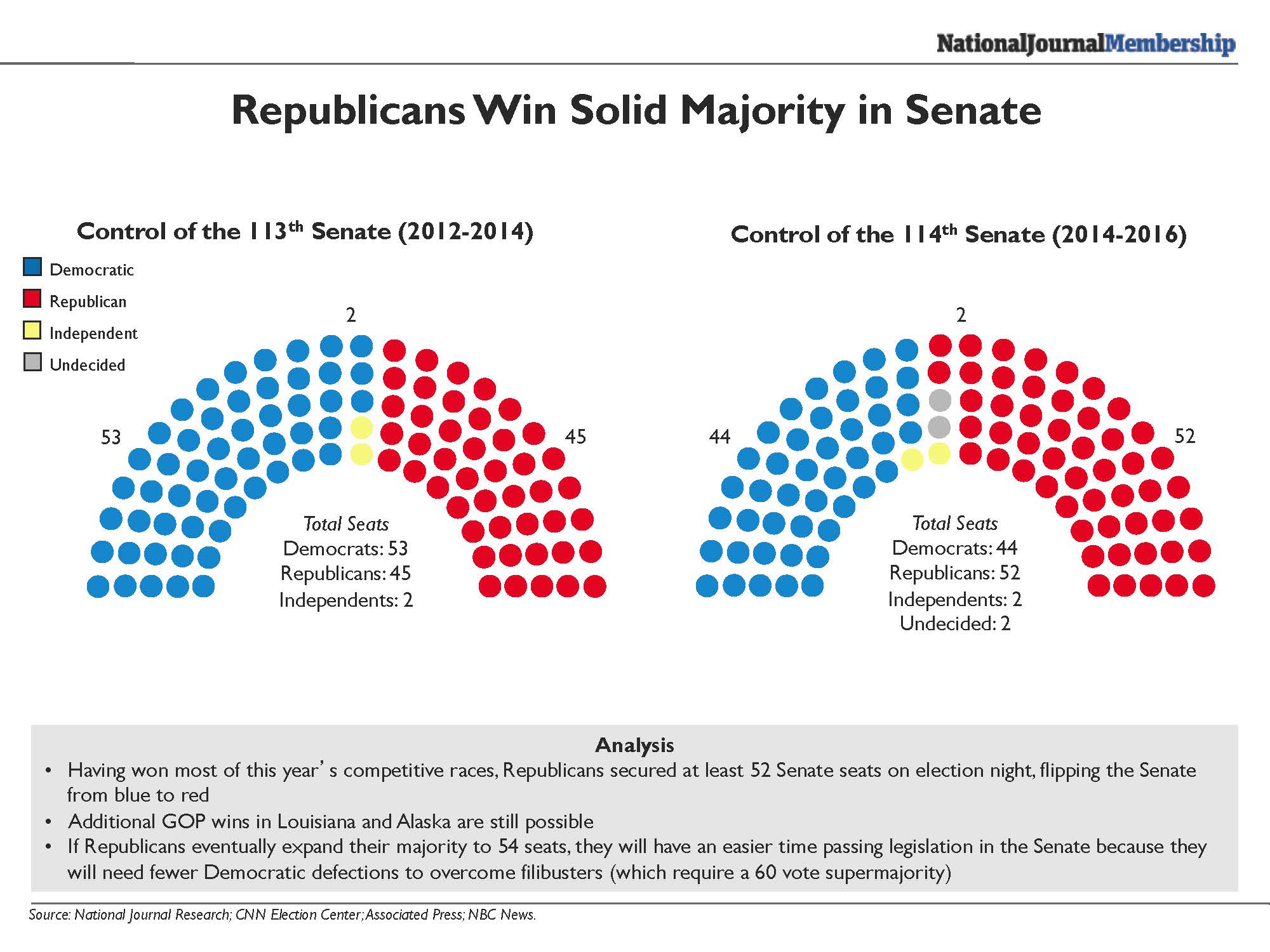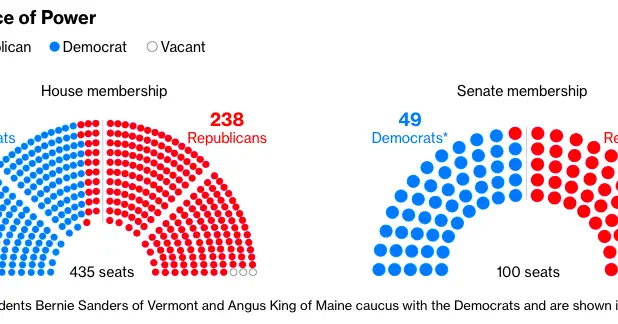Four Flips For Democrats One For Republicans
Going into the election, the Democrats held 47 seats in the U.S. Senate while the Republicans held 53.
The Democrats have succeeded in flipping four seats: in Colorado, where former Governor John Hickenlooper easily ousted incumbent Cory Gardner, in Arizona, where former astronaut Mark Kelly defeated incumbent Martha McSally, and in Georgia, where Raphael Warnock defeated incumbent Kelly Loeffler and Jon Ossoff defeated incumbent David Perdue.
The Republicans have wrested back one previously Democratic seat in Alabama, where one-term incumbent Doug Jones was emphatically denied a second term by Tommy Tuberville, a former college head football coach, most recently at the University of Cincinnati.
Outgoing freshman Sens. Jones and Gardner were both considered vulnerable, as each was elected with less than 50% of the vote in 2018.
Republican Thom Tilliss victory over Cal Cunningham in North Carolinaby less than 2 percentage points according to the North Carolina Secretary of States latest tallyis one of several close Senate races that were not called until after election night. In addition to the seats from Georgia, close races also include the victories of incumbent senators Gary Peters and Susan Collins , which were not called until Nov. 4.
The Fossil Fuel Industrys Funding Of Denial
CAPs analysis of data from the Center for Responsive Politics shows that these 139 climate science deniers have accepted more than $61 million in lifetime direct contributions from the oil, gas, and coal industries, which comes out to an average of $442,293 per elected official of Congress that denies climate change. This figure includes all contributions above the Federal Election Commissions mandated reporting threshold of $200 from management, employees, and political action committees in the fossil fuel industries. Not included in this data are the many other avenues available to fossil fuel interests to influence campaigns and elected officials. For example, oil, gas, and coal companies spent heavily during the 2020 election cycle to keep the Senate under the control of former Majority Leader Mitch McConnell a known climate denierwith major oil companies like Valero, Chevron, and ConocoPhillips contributing more than $1 million each to the conservative Senate Leadership Fund.
This analysis only shows direct, publicly disclosed contributions to federal candidates. The fossil fuel industry regularly spends millions of dollars of dark money advertising to the public; shaping corporate decisions; lobbying members of Congress; and otherwise funding the infrastructure that makes climate denial politically feasible and even profitable.
Read Also: How Many Republicans Voted To Impeach Trump In The House
Focus On Competitive Races
Democrats targeted Republican-held Senate seats in Arizona and Nevada. Seats in Texas,Mississippi and Tennessee were also competitive for the Democrats. Republicans targeted Democratic-held seats in Indiana, Missouri, Montana, North Dakota and West Virginia, all of which had voted Republican in both the 2012 presidential election and the 2016 presidential election. Seats in Florida, Ohio, Pennsylvania, Wisconsin and Michigan, all of which voted for Trump in 2016, were also targeted by Republicans. The Democratic-held seat in New Jersey was also considered unexpectedly competitive due to corruption allegations surrounding the Democratic incumbent.
Recommended Reading: When Did The Southern Democrats Become Republicans
Don’t Miss: Who Is The Speaker Of The House For Republicans
How Many Senators Are Chosen
The Senate of the United States shall be composed of two Senators from each State, elected by the people thereof, for six years; and each Senator shall have one vote. The electors in each State shall have the qualifications requisite for electors of the most numerous branch of the State legislatures.
Membership Qualifications And Apportionment

Under Article I, Section 2 of the Constitution, seats in the House of Representatives are apportioned among the states by population, as determined by the census conducted every ten years. Each state is entitled to at least one representative, however small its population.
The only constitutional rule relating to the size of the House states: “The Number of Representatives shall not exceed one for every thirty Thousand, but each State shall have at Least one Representative.” Congress regularly increased the size of the House to account for population growth until it fixed the number of voting House members at 435 in 1911. In 1959, upon the admission of Alaska and Hawaii, the number was temporarily increased to 437 , and returned to 435 four years later, after the reapportionment consequent to the 1960 census.
Read Also: Are There More Democrats Or Republicans In The Usa
Senators Committees And Other Legislative Groups
The Senates 63 members represent districts from across New York State. Senators belong to a single conference and one or more political parties.
Weve made it easy to filter senators by party, committee, and the other legislative groups in which they gather to consider the merits of proposed legislation and to better understand complex legislative issues.
-
Senator has new policy idea
-
Idea is drafted into a Bill
-
Bill undergoes committee process
-
Senate and Assembly pass bill
-
Bill is signed by Governor
Are Senators Chosen By Popular Vote
Beginning with the 1914 general election, all U.S. senators have been chosen by direct popular election. The Seventeenth Amendment also provided for the appointment of senators to fill vacancies. There have been many landmark contests, such as the election of Hiram Revels, the first African American senator, in 1870.
Don’t Miss: Why Do Republicans Like Donald Trump
Partisan Mix Of The House By State
As of July;30,2021:
| State ranked in partisan order | Percentage |
|---|---|
| OH-11: Vacant following Congresswoman Fudge‘s resignation Mar. 10, 2021.OH-15: Vacant following Congressman Stivers‘s resignation May 16, 2021. | |
| Texas | |
| FL-20: Vacant following Congressman Hastings‘s death on Apr. 6, 2021. | |
| Georgia | |
| State ranked in partisan order | Percentage |
Overlap With Other Forms Of Denial
Ultimately, the findings of this analysis show thatdespite overwhelming scientific evidence to the contraryclimate denial remains alive and well in the United States Congress, and its impacts are already costing lives. Furthermore, dangerous denial within Congress is not limited to climate change alone. By this analysis, 82 members of the U.S. House of Representatives and six U.S. senators are both climate deniers and members of the sedition caucusthose who denied the certified results of the 2020 general election and therefore supported President Trumps violent attempt to overturn these democratic results.*** There is also significant overlap between elected officials who deny climate science and elected officials who deny the reality of the pandemic that has sickened millions and claimed the lives of more than half a million Americans in the past year. In fact, as this analysis was being written, one congressman-elect and another congressman who had both cast doubt on the science around climate change died from COVID-19.
Don’t Miss: How Often Does Joe Manchin Vote With Republicans
Th United States Congress
| Members |
|---|
| 1st: January 6, 2015 December 18, 20152nd: January 4, 2016; January 3, 2017 |
The 114th United States Congress was a meeting of the legislative branch of the United States of America federal government, composed of the United States Senate and the United States House of Representatives. It met in Washington, D.C. from January 3, 2015, to January 3, 2017, during the final two years of Barack Obama’s presidency. The seats in the House were apportioned based on the 2010 United States Census.
The 2014 elections gave the Republicans control of the Senate and the House for the first time since the 109th Congress. With 248 seats in the House of Representatives and 54 seats in the Senate, this Congress began with the largest Republican majority since the 71st Congress of 19291931. As of 2021, this is the most recent session of Congress in which Republicans and Democrats held any seats in New Hampshire and Nebraska, respectively, and the last in which Republicans held a Senate seat in Illinois.
About The House Of Representatives
The United States is also divided into 435 congressional districts with a population of about 750,000 each. Each district elects a representative to the House of Representatives for a two-year term.
As in the Senate, the day-to-day activities of the House are controlled by the majority party. Here is a count of representatives by party:
Also Check: Why Did Democrats And Republicans Switch
Many Republicans Mobilizing Against Bipartisan Infrastructure Bill
The bipartisan group of senators who crafted the Infrastructure Investment and Jobs Act is preparing to take a victory lap as the Senate moves toward passing the bill in the coming days.
But a large number of Republicans are mobilizing against the bill that includes $1.2 trillion of spending and $550 billion in new spending on hard infrastructure projects, such as rail, ports, electric vehicle charging stations, and broadband.
Right after the group of bipartisan senators introduced the bills text on Sunday night, Utah Republican Sen. Mike Lee gave a long floor speech in opposition to the legislation, arguing that the Constitution does not give Congress to go out and spend money on anything that we deem appropriate and that the price tag is too high.
Shame on us for making poor and middle-class Americans poorer so that we can bring praise and adulation to ourselves and more money to a small handful of wealthy, well-connected interests in America, Lee said.
Missouri Republican Sen. Josh Hawley said that he would vote against the bill, sharing an article that called it an epic binge of green subsidies and more handouts for states and localities.
Several Republicans in the House are also stating their opposition to the bill.
No one should support something that will serve as a trojan horse for the Democrats reconciliation package, which the White House wants to use to pass massive amnesty, the RSC memo read.
Washington Examiner Videos
Senate Intergovernmental Operations Committee Plans First Public Hearing Of Election Investigation

The Senate Intergovernmental Operations Committee plans to hold the first public hearing of its investigation into the 2020 General Election and the 2021 Primary Election on Thursday, September 9, at the Capitol Building in Harrisburg, according to Committee Chairman Senator Cris Dush . ;
The Senate Intergovernmental Operations Committee has created a special webpage for Pennsylvania residents to submit sworn testimony regarding problems they have personally experienced with the states election system, according to Committee Chair Senator Cris Dush . ;
Read Also: How Many Senate Republicans Are There
How Are The Results Reported
The election results on this page are reported by the Associated Press . AP call the winner in a state when they determine that the trailing candidate has no path to victory. This can happen before 100% of votes in a state have been counted.
Estimates for the total vote in each state are also provided by AP. The numbers update throughout election night, as more data on voter turnout becomes available.
Are Canadian Senators Appointed For Life
Unlike the Members of Parliament in the House of Commons, the 105 senators are appointed by the Governor General on the advice of the prime minister. Senators originally held their seats for life; however, under the British North America Act, 1965, members may not sit in the Senate after reaching the age of 75.
Don’t Miss: Is Red The Color Of Republicans
Senate And House Elections 2020: Full Results For Congress
As well as electing the US president, the country has been voting for senators and members of the House of Representatives. Here are full results from all 50 states
Mon 9 Nov 2020 09.44;GMT Last modified on Tue 15 Dec 2020 14.28;GMT
Mon 9 Nov 2020 09.44;GMT Last modified on Tue 15 Dec 2020 14.28;GMT
The US legislature, Congress, has two chambers. The lower chamber, the House of Representatives, has 435 voting seats, each representing a district of roughly similar size. There are elections in each of these seats every two years.
The upper chamber, the Senate, has 100 members, who sit for six-year terms. One-third of the seats come up for election in each two-year cycle. Each state has two senators, regardless of its population; this means that Wyoming, with a population of less than 600,000, carries the same weight as California, with almost 40 million.
Most legislation needs to pass both chambers to become law, but the Senate has some important other functions, notably approving senior presidential appointments, for instance to the supreme court.
In most states, the candidate with the most votes on election day wins the seat. However, Georgia and Louisiana require the winning candidate to garner 50% of votes cast; if no one does, they hold a run-off election between the top two candidates.
How Many Republican Senators Are There In California
4.1/5
| Total | 100 |
Beside above, how many Republicans are in California? In February 2019, California had 19,978,449 registered voters, comprising 79.09% of its total eligible voters. Of those registered voters, 8,612,368 were registered Democrats, and 4,709,851 were Republicans.
In this regard, who are the Republican senators in California?
California elects United States senators to Class 1 and Class 3. The state has been represented by 44 people in the Senate since it was admitted to the Union on September 9, 1850. Its current U.S. senators are Democrats Dianne Feinstein and Kamala Harris.
Who are my senators in California?
Kamala Harris Since;2017 Dianne Feinstein
Recommended Reading: Why Do Republicans Still Back Trump
Democrats Got Millions More Votes So How Did Republicans Win The Senate
Senate electoral process means although Democrats received more overall votes for the Senate than Republicans, that does not translate to more seats
The 2018 midterm elections brought significant gains for Democrats, who retook the House of Representatives and snatched several governorships from the grip of Republicans.
But some were left questioning why Democrats suffered a series of setbacks that prevented the party from picking up even more seats and, perhaps most consequentially, left the US Senate in Republican hands.
Among the most eye-catching was a statistic showing Democrats led Republicans by more than 12 million votes in Senate races, and yet still suffered losses on the night and failed to win a majority of seats in the chamber.
Constitutional experts said the discrepancy between votes cast and seats won was the result of misplaced ire that ignored the Senate electoral process.
Because each state gets two senators, irrespective of population, states such as Wyoming have as many seats as California, despite the latter having more than 60 times the population. The smaller states also tend to be the more rural, and rural areas traditionally favor Republicans.
This year, because Democrats were defending more seats, including California, they received more overall votes for the Senate than Republicans, but that does not translate to more seats.
The rise of minority rule in America is now unmistakable
With Control Of White House And Congress Democrats Have 2 Years To Make Big Changes
Sorry, but your browser cannot support embedded video of this type, you can to view it offline.
U.S. Democrats secured unified control of the White House and Congress on Wednesday with the inauguration of President Joe Biden followed by Vice President Kamala Harris swearing in three new Democratic senators.
The three new senators bring the U.S. Senate to a 50-50 Democratic-Republican tie, with Harris as the presiding officer representing the tie-breaking vote.
With the U.S. House continuing under the leadership of Democratic House Speaker Nancy Pelosi, Biden begins his term with the opportunity to work with the two Democrat-controlled chambers to enact significant legislative changes.;
As a result of the shifting political power on Capitol Hill, Senate Democratic leader Chuck Schumer of New York has succeeded Republican Mitch McConnell as Senate majority leader. The Kentucky senator, who served in the top leadership post for six years, was highly skilled at blocking Democratic legislation, as well as advancing former President Donald Trump’s judicial and administration nominees through the confirmation process.;
Schumer acknowledged some of those challenges Wednesday in his first speech as majority leader.
“This Senate will tackle the perils of the moment: a once-in-a-generation health and economic crisis. And it will strive to make progress on generations-long struggle for racial justice, economic justice, equality of opportunity and equality under the law,” Schumer said.
Also Check: How Many Republicans Are Now In The House Of Representatives
Arguments For Expanding The Number Of House Members
Advocates;for increasing the number of seats in the House say such a move would increase the quality of representation by reducing the number of constituents each lawmaker represents. Each House member now represents about 710,000 people.
The group ThirtyThousand.org argues that the framers of the Constitution and the Bill of Rights never intended for the population of each congressional district to exceed 50,000 or 60,000. “The principle of proportionally equitable representation has been abandoned,” the group argues.
Another argument for increasing the size of the House is that is would diminish the influence of lobbyists. That line of reasoning assumes that lawmakers would be more closely connected to their constituents and therefore less likely to listen to special interests.
Climate Deniers In The 117th Congress

According to new analysis from the Center for American Progress, there are still 139 elected officials in the 117th Congress, including 109 representatives and 30 senators, who refuse to acknowledge the scientific evidence of human-caused climate change. All 139 of these climate-denying elected officials have made recent statements casting doubt on the clear, established scientific consensus that the world is warmingand that human activity is to blame. These same 139 climate-denying members have received more than $61 million in lifetime contributions from the coal, oil, and gas industries.
Also Check: What Were The Reconstruction Goals Of The Radical Republicans
